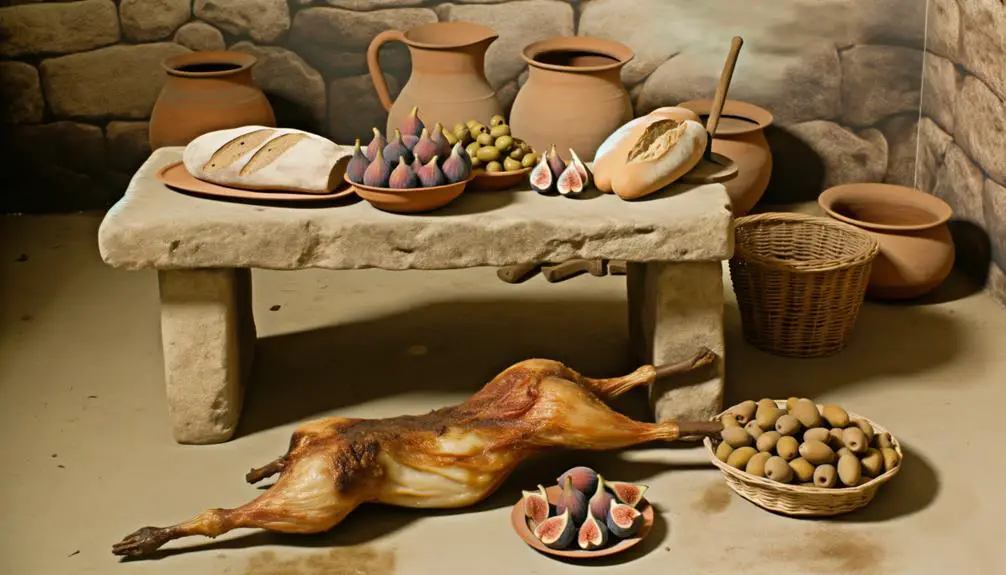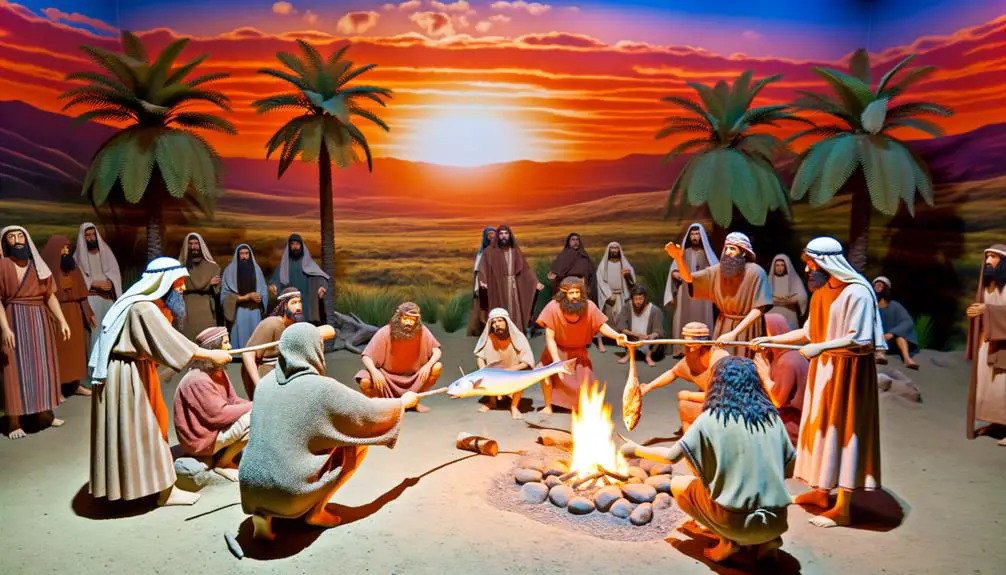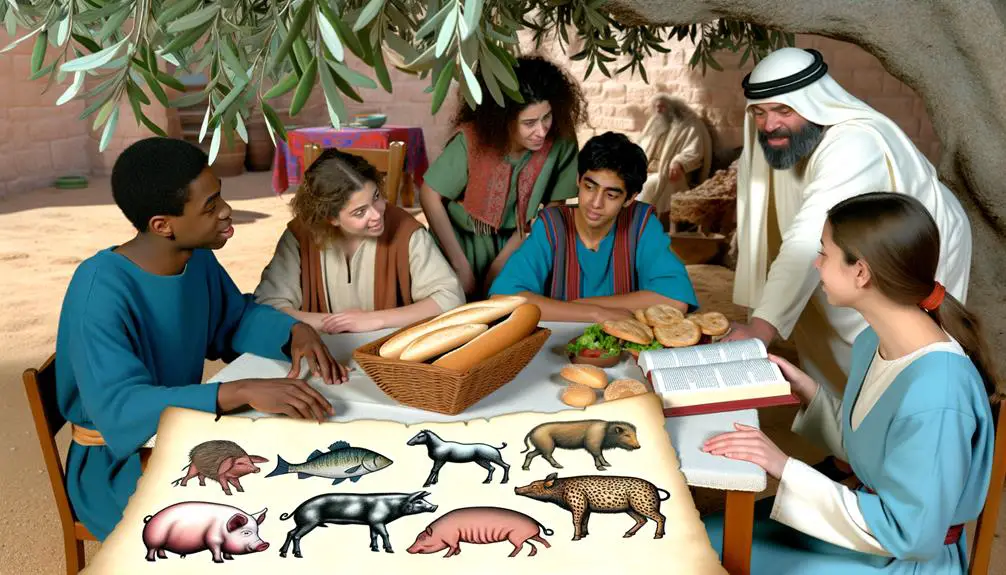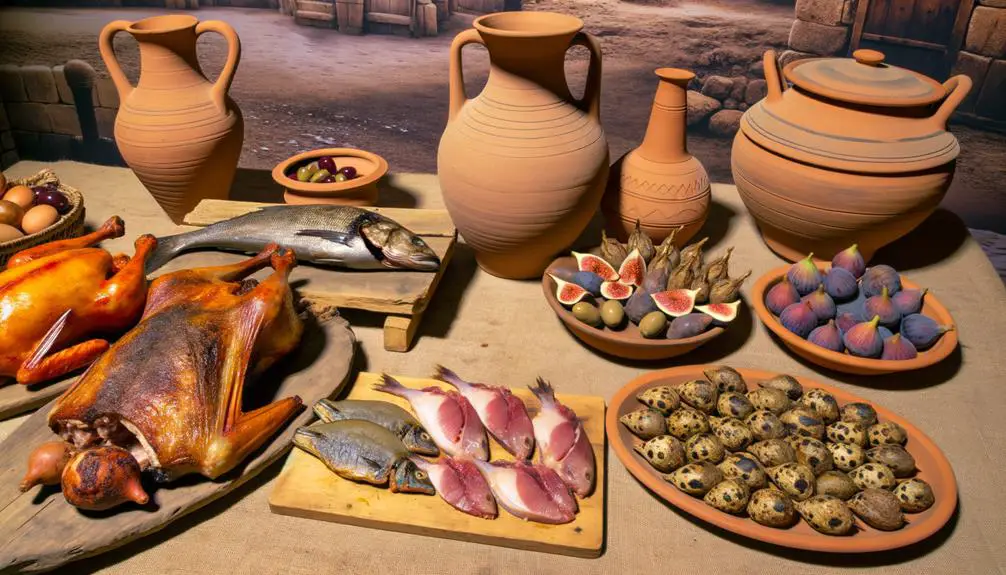Curious about biblical diets? Discover how meat influenced culture, religion, and morality in ancient times—read on to unveil the deeper connections.

Did They Eat Meat in the Bible
In the Bible, you'll discover that meat was indeed consumed and played a profound role both culturally and religiously. Meat consumption was intertwined with themes of providence, purity, and blessing. It wasn't just about sustenance; it carried significant symbolic weight in narratives, religious rituals, and social structures. For instance, distinctions between clean and unclean meats not only reflected dietary laws but also moral and spiritual values of the community. Meat offerings in sacrifices expressed reverence and obedience toward God, reinforcing communal bonds. Exploring further, you might learn how these practices influenced broader biblical teachings and historical contexts.
Key Takeaways
- Yes, meat was consumed in the Bible, particularly from clean animals like cattle, sheep, and goats.
- Meat consumption was often linked to religious rituals and feasts.
- Dietary laws differentiated between clean and unclean meats, affecting what could be consumed.
- Meat offerings in sacrifices symbolized reverence and obedience to God.
- Communal meals that included meat reinforced social and religious bonds among participants.
Biblical References to Meat

In the Bible, meat consumption surfaces in various contexts, reflecting its cultural, religious, and ethical dimensions. You'll find that meat often carries deeper symbolic meanings, particularly in narratives where hunting practices are mentioned. For instance, when Esau is described as a skilled hunter who brings venison to his father Isaac, this isn't just a detail about diet. It underscores themes of providence, blessing, and the right of the firstborn, intertwining the physical act of hunting with spiritual and familial implications.
Moreover, the distinction between clean and unclean animals, which dictates what meat is permissible for consumption, further enriches the symbolism. This classification isn't merely dietary; it serves as a boundary marker between those inside and outside the covenant community. In this way, meat becomes a symbol of purity and consecration.
Analyzing these instances, you see that meat and hunting aren't straightforwardly about sustenance. They reflect and reinforce social structures, religious practices, and moral codes. When you read biblical references to meat, you're not just encountering ancient dietary habits. You're delving into a rich tapestry of symbols that communicate much about how these communities understood their world and their God.
Meat in Religious Rituals
Beyond the symbolic meanings of meat in narratives and laws, its role in religious rituals further highlights its spiritual significance. As you explore the ancient texts, you'll notice that meat was pivotal in many religious observances, reflecting both devotion and community bonds. These historical sacrifices weren't just about the act of offering, but deeply embedded in the spiritual fabric of the community.
Here's how meat played an essential role in religious rituals:
- Offerings to God: In Biblical times, offering meat in sacrifices was a way to show reverence and obedience to God. It was believed that the aroma of the sacrifice was pleasing to God, symbolizing the community's respect and worship.
- Symbol of Covenant: During significant religious ceremonies, such as the sealing of covenants, meat was often consumed to signify the solemnity of the occasion and the mutual commitment being undertaken.
- Communal Meals: After some sacrifices, the cooked meat was shared among the community in a feast that reinforced social and religious ties. This act of sharing not only distributed the sacred but also promoted unity among the participants.
Understanding these historical contexts enriches your grasp of modern interpretations, revealing how ancient practices inform contemporary religious perspectives and rituals.
Dietary Laws and Restrictions

Exploring further, you'll find that dietary laws and restrictions in the Bible are not simply about health but deeply intertwined with spiritual purity and identity. The Levitical laws, for instance, categorize foods as clean or unclean, emphasizing a diet that supports both physical well-being and spiritual cleanliness. You'll notice that these laws were crucial in setting the Israelites apart from their neighbors, underscoring their unique relationship with God.
As you investigate more deeply, you'll see that some scholars suggest that the biblical endorsement of plant-based meals aligns with vegetarian interpretations of scripture. For example, in Genesis 1:29, God provides plants and fruits as food, a point which some interpret as indicating a divine preference for vegetarianism before the Fall. This perspective posits that the original diet intended by God was rich in fruits and vegetables, and devoid of meat.
Analyzing these texts, it's evident that the dietary rules were multifaceted, serving not only in religious ritual but also in promoting a lifestyle that is reflective of spiritual convictions. These guidelines weren't just arbitrary but were laden with symbolic meanings that reinforced the moral and spiritual fabric of the community. Therefore, understanding these laws provides deeper insight into the biblical worldview and its foundational values.
Social Significance of Meat
While the dietary laws often highlight restrictions on meat, its consumption also holds profound social significance in biblical contexts. You'll find that meat was not merely sustenance but a pivotal element in social structures, marking both economic status and participation in cultural celebrations.
Here's how meat played an important role:
- Indicator of Wealth: In biblical times, the ability to offer meat at a meal was a clear indicator of one's economic status. Frequent meat consumption was generally reserved for the affluent or for special occasions among the common folk, as raising livestock was resource-intensive.
- Central to Feasts and Rituals: Meat was integral to major cultural celebrations. Feasts often involved the slaughter of livestock, which not only provided food but also served as a communal activity that strengthened bonds within the community.
- Symbolic in Religious Observances: In many religious ceremonies, the offering of meat sacrifices was essential. These acts were deeply embedded with symbolic meanings, often representing atonement, thanksgiving, or covenantal rituals between the divine and the people.
Understanding these layers, you grasp how meat transcended simple dietary sustenance and wove into the very fabric of societal and religious life, reflecting and reinforcing the social hierarchies and spiritual beliefs of the time.
Varieties of Meat Consumed

Various types of meat were consumed in biblical times, each holding distinct cultural and religious significance. You'll find that the Hebrew Bible details a range of animals deemed important and essential for consumption, such as cattle, sheep, goats, and certain types of birds. The diets of ancient people weren't just about sustenance but also intertwined with the observance of religious laws and rites.
The techniques used for acquiring and preserving meat were essential for maintaining a stable food supply. Hunting techniques, for instance, weren't merely acts of killing; they required a deep understanding of animal behavior, seasonal patterns, and the geography of the land. Hunters in biblical times used tools like slings, bows, and perhaps early forms of traps to capture their prey, ensuring that their communities were nourished.
Meat preservation methods were equally important. Without modern refrigeration, people of that era relied on salting, smoking, and drying to extend the edibility of meat. These methods not only prevented spoilage but also allowed for the transport of meat across distances, which was essential for trade and for feeding nomadic tribes. This careful management of resources reflects a profound respect for the provisions granted by nature, viewed by many as blessings from God.
Frequently Asked Questions
How Did Meat Preservation Methods Differ in Biblical Times?
In biblical times, you'd find that meat preservation was primarily through salt curing and smoking techniques. These methods were essential for sustenance and played a critical role in dietary practices throughout ancient communities.
Were There Vegetarian Communities Mentioned in the Bible?
In the Bible, vegetarian communities aren't explicitly detailed, but Daniel's diet, primarily plant-based, suggests such practices. Eden's food, symbolizing purity and simplicity, aligns with a vegetarian ethos, reflecting early biblical dietary ideals.
Did Biblical Figures Hunt for Their Own Meat?
In biblical times, you'd find that figures often hunted their own meat, employing various gathering techniques. This practice intertwined with religious observances, highlighting animal sacrifices, reflecting a deep, symbolic communion between man and divine mandates.
How Did Meat Consumption Impact Health in Biblical Times?
In biblical times, dietary laws greatly influenced meat consumption, impacting health outcomes. Nutrition analysis suggests that these regulations guaranteed a balanced intake, potentially reducing diseases linked to dietary excesses or deficiencies.
Were There Ethical Considerations About Eating Meat Discussed in the Bible?
Yes, the Bible does discuss ethical considerations about eating meat, especially through animal sacrifices and divine commands, which you might find illuminating as they reflect a deep respect for life and divine providence.


Sign up